- This topic has 10 replies, 5 voices, and was last updated 8 years, 1 month ago by
 Paul Anthony Brierley.
Paul Anthony Brierley.
-
AuthorPosts
-
20 November 2017 at 11:27 pm #573892
 Bill WardParticipant
Bill WardParticipantHi,
Despite the usual poor weather I have been able to get a couple of decent nights. The acivity has been quite low but I did record some nice Leonids on the video systems. Unfortunately I didn’t get a single meteor on the DSLR’s with the lc shutters 🙁
I did catch a really nice spectrum on the morning of the 17th. Initially I assigned this as a sporadic but after seeing a spectrum by William Stewart re-examined mine. A closer inspection of the background revealed that this was indeed probably a Leonid afterall.
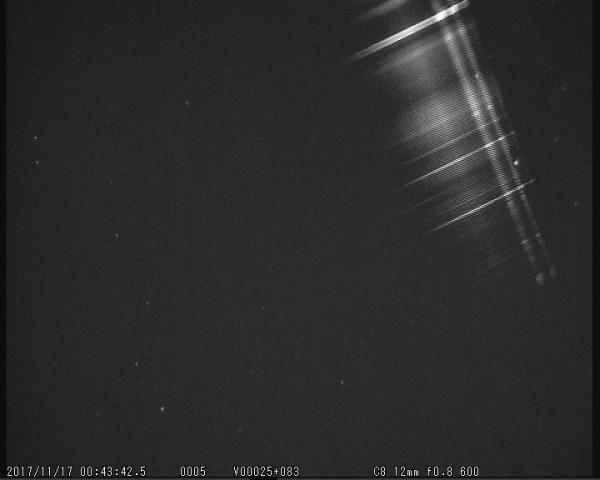
This spectrum showed some really interesting effects in the flaring regions. The ionised lines of calcium, magnesium and silicon light up strongly. This illustrates the rapidly changing temperatures within the meteor head region.
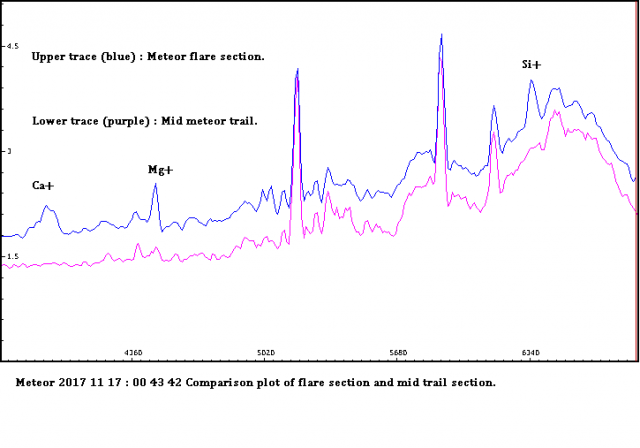
A good result!
Cheers,
Bill.
21 November 2017 at 11:47 am #578776 Alex PrattParticipant
Alex PrattParticipantHi Bill,
I think you can conclusively claim this to be a Leonid meteor spectrum.
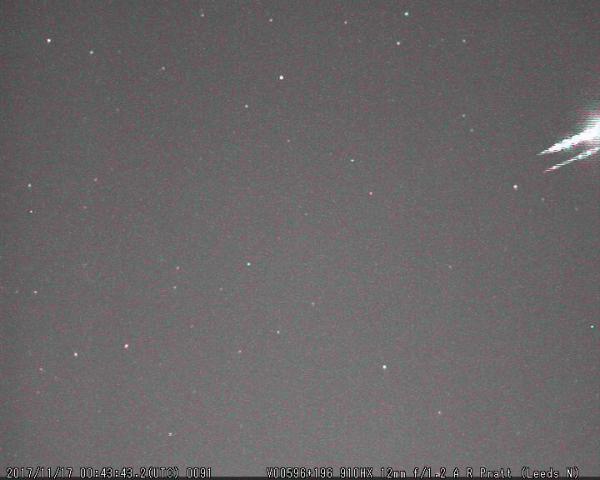
The attached composite image was captured by my indoor Leeds_N camera, a mag -1.5 Leonid, confirmed by UFO Analyser. The meteor was recorded as it flashed into the RHS of the field of view. The brighter upper trail is the Leonid, the fainter lower trail is an artefact of the double glazing.
Cheers,
Alex.
21 November 2017 at 1:23 pm #578775 Andrew RobertsonParticipant
Andrew RobertsonParticipantI was at Kelling Heath and had 3 clear nights in a row on the Thur/Fri/Sat. Very poor display this year, only saw a handful, most in the early hours of Friday morning (17th) but did see a leonid fireball in the early hours of Sunday morning. I was facing the opposite direction and thought a car headlight was driving onto the field, turned around in time to see it brighten then explode. Must have been at least mag -10 as far brighter than the brightest irridium flare which can reach about -8. Left a trail about 2 degrees long which lasted for about 10 seconds – Brilliant! Gain Lee saw it also.
Andrew
21 November 2017 at 3:44 pm #578778 Bill WardParticipant
Bill WardParticipantHi,
That is excellent news, I wonder what the final flare mag would have been. I’d have thought it brighter than -1.5 to give the spectrum it did. Applying my own principles of comparative spectroscopy I overlaid Williams and my own and the correspondance is excellent.
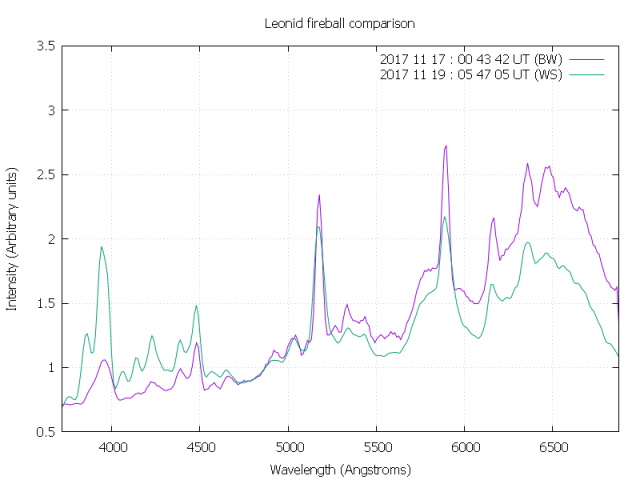
The varying gradients are due to flat field calibration issues. I’ll need to investigate this a bit more however it was an interesting catch with the rapid changes to the metal lines over essentially a single frame.
Seeing your fov I’ll try lowering my camera a bit, They’re all quite high to avoid light pollution diffraction issues, I’ll see if I can get a way with it.
I’m a bit dissapointed I never caught a thing with my dslr rig. I had thw two cameras with the LC shutters on for 8 hours! There were a few periods with some high cloud but 16/17 turned out to be a decent nights observing.
Cheers,
Bill.
21 November 2017 at 4:28 pm #578780 Bill WardParticipant
Bill WardParticipantBy way of a comparison here’s the Leonid composite spectrum image and the best Lyrid one I got this year.
The change in velocity certainly affects the ablation heights and thus the appearence of the 557.7nm forbidden O Line.
(I’m hoping Alex will have some info on the heights of the Lyrids as determined by the Nemetoders…)
This line is a very useful rough and ready diagnostic tool!
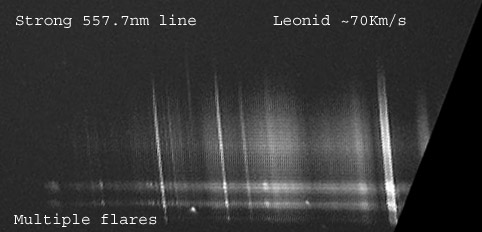

cheers,
Bill.
21 November 2017 at 5:20 pm #578781 Alex PrattParticipant
Alex PrattParticipantHi Bill,
The analysis gave the meteor an apparent magnitude of -1.5, as seen from my location. A meteor’s absolute magnitude is its estimated magnitude had it been in the observer’s / camera’s zenith at an altitude of 100 km. This meteor could easily have appeared brighter from your station.
It can be challenging to record meteors with a DSLR. Lens effective aperture and ISO setting are big factors. I have an example of a bright Perseid that was spectacular on my video camera but a much more feeble streak on my DSLR image.
Clear skies,
Alex.
21 November 2017 at 5:30 pm #578782 Alex PrattParticipant
Alex PrattParticipantHi Bill,
Here’s some plots from NEMETODE data showing the detection and extinction altitudes of the meteor family. The geocentric velocity of each meteor shower is indicated by Vg.
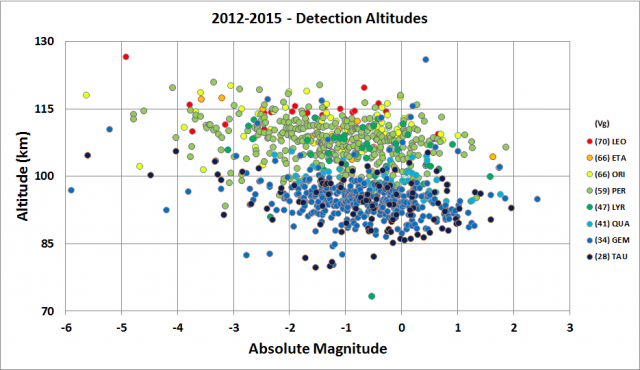
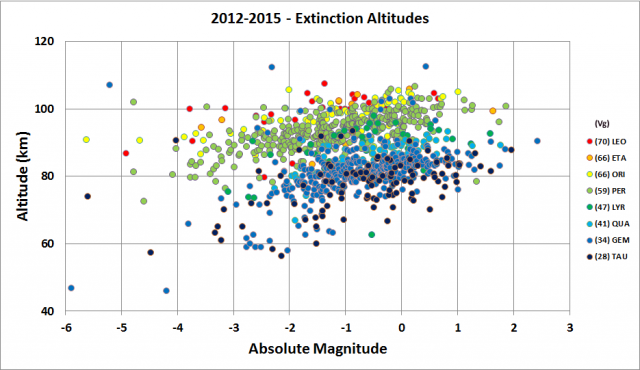
I’ll be updating these plots in the New Year with data from 2016-2017.
Clear skies,
Alex.
22 November 2017 at 9:45 am #578792 Bill WardParticipant
Bill WardParticipantHi,
Thanks Alex, further to my email about Nemetode, since I first pointed a watec camera at the sky in winter of 2005/2006, revolution is the only word to describe whats been going on in meteor astronomy over those years. Next year, will be a decade of meteor spectrosopy from my place. I enjoy reading old astronomy books and my latest one, from the late 50’s has the line “meteor spectroscopy is the greatest challenge, there are no more than a few score of specta available to researchers…it is nearly impossible to identify individual lines…” The other really curious thing from that book is a table one line of which states that only 2% of meteors show lines of sodium. The hundreds that I now have show the exact reverse! there are very few that DON’T show sodium. I use it as one of the standard markers! How times change…
Roll on the Geminids but I’m going to try and not break any more bones on my way to observing!
cheers,
Bill.
26 November 2017 at 11:53 am #578807 William StewartParticipant
William StewartParticipantHi All,
Bill referenced a spectrum at the beginning of this thread that I’d captured back on 19th Nov 2017 at 05:47:05 GMT. It turns out that it was of a Leonid Fireball (absolute magnitude -7.2). Broadband problems are currently preventing me from uploading videos / addition details to the website however have attached some initial results. Thanks to the NEMETODE team as well as the multiple radio observers around the country. Fantastic to be part of such a collaborative team – meteor observing has come a long way in the past few years.
Best regards
William
26 November 2017 at 11:55 am #578808 William StewartParticipant
William StewartParticipantWould help if I attached the images!
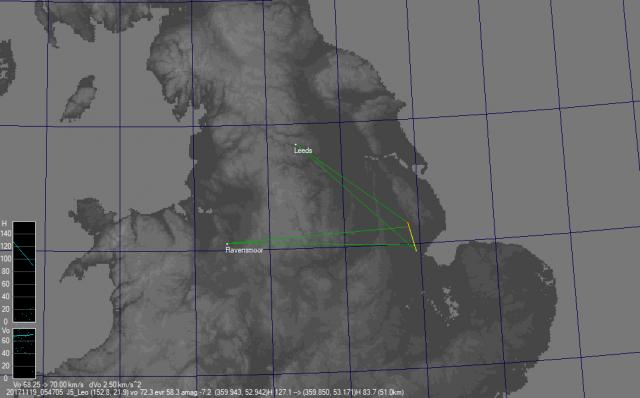
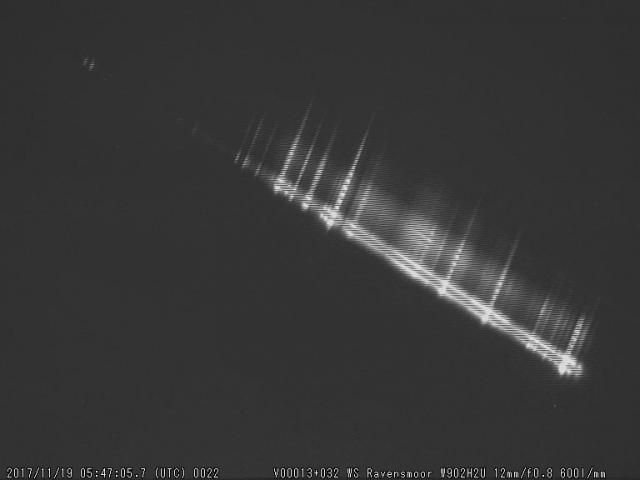 28 November 2017 at 6:39 am #578816
28 November 2017 at 6:39 am #578816 Paul Anthony BrierleyParticipant
Paul Anthony BrierleyParticipantDidn’t stand a chance this year. Cloudy and wet.
Hopefully the skies will finally clear, for the Geminids-Ursids.
-
AuthorPosts
- You must be logged in to reply to this topic.
